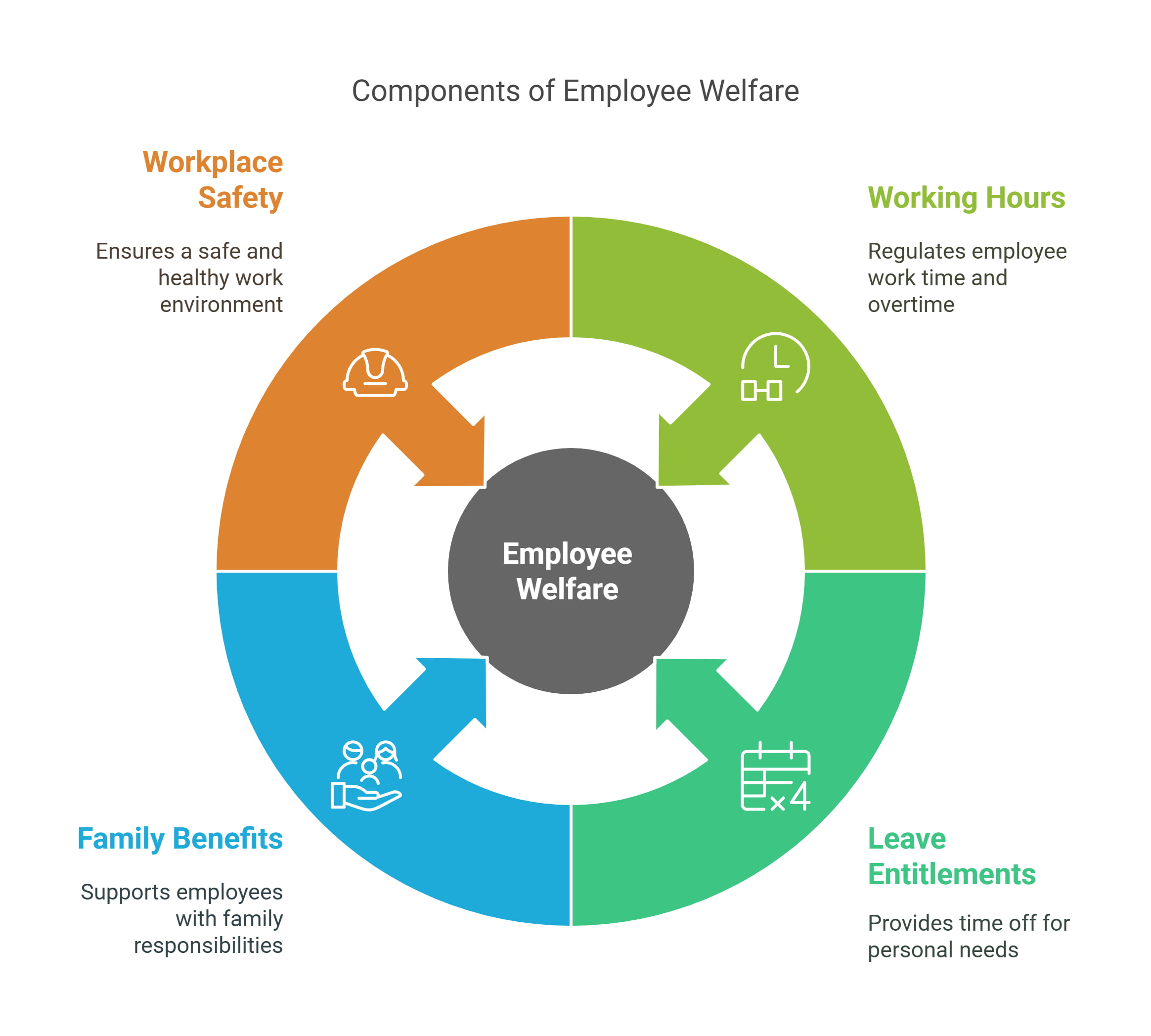Labour laws in Pakistan are a crucial framework that governs employment practices and worker rights. For HR teams, understanding and complying with these regulations is essential for maintaining a harmonious and legally compliant workplace. In this comprehensive guide, we delve into the key aspects of labour laws in Pakistan, providing HR professionals with an in-depth understanding to navigate the complexities of employment regulations effectively.
Introduction to Labour Laws in Pakistan
Labour laws in Pakistan are rooted in the Constitution of Pakistan and further elaborated through various Acts, Ordinances, and rules. These laws cover diverse aspects of employment, including wages, working hours, employee benefits, workplace safety, and dispute resolution mechanisms. They aim to protect both employees and employers while fostering fair labor practices.

Key Labour Legislations in Pakistan
Pakistan has a robust legal framework designed to regulate the relationship between employers and employees. These laws aim to promote fair labor practices, ensure workplace safety, and protect worker rights. Below is an overview of some of the most important labour legislations in Pakistan:
1. The Industrial and Commercial Employment (Standing Orders) Ordinance, 1968
This ordinance governs the terms of employment for workers in industrial and commercial establishments. It specifies:
- Classification of Workers: Workers are categorized as permanent, probationary, temporary, or apprentice.
- Termination Procedures: Employers must provide notice or compensation for termination.
- Disciplinary Actions: Guidelines for handling misconduct and disciplinary measures.
2. Factories Act, 1934
The Factories Act (1934) emphasizes workplace safety and welfare in manufacturing establishments. Key provisions include:
- Working Hours: Limits of 48 hours per week and overtime regulations.
- Health and Safety: Measures for ventilation, sanitation, and hazard prevention.
- Welfare Facilities: Provisions for drinking water, restrooms, and first aid.
3. Payment of Wages Act, 1936
This act ensures timely payment of wages and prohibits unauthorized deductions. Employers must:
- Pay wages within seven days after the end of the wage period.
- Avoid arbitrary wage reductions.
4. Minimum Wages Ordinance, 1961
The ordinance mandates a minimum wage to ensure fair compensation. It is updated periodically by the government and applies to specific industries and occupations.
5. Shops and Establishments Ordinance, 1969
This ordinance regulates working conditions for employees in shops and commercial establishments. It includes:
- Weekly holidays and working hour restrictions.
- Leave policies, including annual, casual, and sick leave.
6. Employees’ Old-Age Benefits Institution (EOBI) Act, 1976
The EOBI scheme provides financial security for retired and elderly workers. Employers contribute to this fund, ensuring workers receive pensions, survivor benefits, and disability allowances.
7. Workers’ Welfare Fund Ordinance, 1971
This ordinance creates a fund for workers’ welfare, financed by employer contributions. Benefits include:
- Housing and Education: Funding for housing schemes and scholarships for workers’ children.
- Healthcare: Access to medical facilities and healthcare support.
8. The Workmen’s Compensation Act, 1923
This act ensures compensation for workers who are injured or disabled in the course of their employment. Key provisions include:
- Employer Liability: Employers must compensate workers for workplace accidents or injuries.
- Payment Criteria: Compensation is based on the severity of injury or disability.
9. Protection Against Harassment of Women at the Workplace Act, 2010
This modern legislation aims to create a safe working environment for women. Key components include:
- Code of Conduct: Establishes a code for respectful behavior.
- Complaint Mechanism: Guidelines for filing and addressing harassment complaints.
- Penalties: Outlines disciplinary actions against perpetrators.
10. The Trade Unions Act, 1926
This act regulates the formation and functioning of trade unions. Key highlights include:
- Union Registration: Defines procedures for forming and registering trade unions.
- Collective Bargaining: Allows workers to negotiate wages and conditions with employers.
- Dispute Resolution: Mechanisms for resolving industrial disputes through conciliation or arbitration.
11. Employment of Children Act, 1991
This act prohibits child labor and ensures the protection of children in the workplace. Provisions include:
- Age Restrictions: Prohibits employment of children below 14 years in hazardous occupations.
- Working Conditions: Specifies conditions for employment of adolescents (14–18 years) in non-hazardous jobs.
12. Bonded Labour System (Abolition) Act, 1992
This act abolishes bonded labor and prohibits forced labor practices. Key features include:
- Freedom for Workers: Declares bonded labor agreements void.
- Penalties: Imposes fines and imprisonment for employers engaging in bonded labor practices.
These laws collectively form the foundation of labour regulations in Pakistan. For HR teams and employers, understanding these legislations is crucial for maintaining compliance, fostering a fair work environment, and avoiding legal complications.

Rights and Benefits Under Pakistani Labour Laws
Pakistani labour laws are designed to protect the rights of employees and ensure that employers provide fair working conditions. These laws cover various aspects of employment, including wages, working hours, leave policies, workplace safety, and social security. Below is a detailed overview of the rights and benefits available to employees under Pakistani labour laws.
1. Working Hours and Overtime
Labour laws stipulate that employees should not work more than:
- 8 hours per day or 48 hours per week.
- Overtime is compensated at double the normal rate.
2. Leave Entitlements
Employees are entitled to:
- Annual Leave: 14 days after one year of service.
- Casual Leave: 10 days per year for emergencies.
- Sick Leave: Medical leave with proper documentation.
3. Maternity and Paternity Benefits
- Women are entitled to 12 weeks of paid maternity leave under the Maternity Benefits Ordinance, 1958.
- Some organizations also offer paternity leave for fathers.
4. Workplace Safety and Welfare
The law mandates:
- Adequate safety measures in workplaces, including fire safety and protective gear.
- Welfare amenities such as clean drinking water, restrooms, and healthcare facilities.
Labour laws in Pakistan aim to balance the rights and responsibilities of employers and employees, fostering a fair and equitable working environment. For employees, understanding these rights and benefits is essential to ensure they receive the treatment and opportunities they are entitled to. Employers must also adhere to these laws to build trust, maintain compliance, and avoid legal challenges.

Compliance Requirements for HR Teams
HR teams play a pivotal role in ensuring that organizations comply with labour laws and maintain fair and legally sound employment practices. Non-compliance can lead to legal penalties, financial losses, and reputational damage. Below is a detailed guide to compliance requirements for HR teams in Pakistan.
1. Maintenance of Records
Proper documentation is a cornerstone of compliance. HR teams must:
- Employee Registers: Maintain up-to-date records of all employees, including their personal information, employment status, and job roles.
- Attendance Records: Keep accurate logs of employees’ working hours, overtime, and leaves.
- Salary and Wage Registers: Document salary payments, deductions, and bonuses in compliance with the Payment of Wages Act, 1936.
2. Employee Contracts
HR teams must ensure that every employee has a formal, written employment contract. Key elements include:
- Job Description: Clearly outline the employee’s responsibilities.
- Terms of Employment: Specify working hours, probationary periods, and notice requirements.
- Salary and Benefits: Detail the compensation package, including allowances and bonuses.
- Termination Clauses: Include provisions for lawful termination and severance.
3. Compliance with Minimum Wage Laws
HR teams must ensure employees receive at least the government-mandated minimum wage. This includes:
- Periodic Updates: Adjusting wages when the government revises the minimum wage.
- Documentation: Keeping records of wage compliance for audits and inspections.
4. Implementation of Leave Policies
Labour laws in Pakistan mandate specific leave entitlements. HR teams must:
- Track Leave Balances: Maintain records of annual, casual, and sick leave for each employee.
- Approval Processes: Implement transparent systems for leave application and approval.
- Compliance with Maternity and Paternity Leave: Adhere to the Maternity Benefits Ordinance, 1958, and other applicable policies.
5. Ensuring Workplace Safety
The Factories Act, 1934, and other labour laws require employers to provide a safe working environment. HR teams should:
- Conduct Risk Assessments: Identify potential hazards in the workplace.
- Implement Safety Measures: Provide protective equipment, first aid, and training programs.
- Report Incidents: Maintain logs of workplace accidents and take corrective actions promptly.
6. Social Security and EOBI Contributions
HR teams must ensure compliance with social security regulations, including:
- Employee Registration: Register eligible employees with the Employees’ Old-Age Benefits Institution (EOBI) and provincial social security institutions.
- Timely Contributions: Deduct and deposit employer and employee contributions to EOBI and other welfare funds.
- Record Keeping: Maintain documentation of contributions and benefits for audits.
Compliance with labour laws in Pakistan requires diligent efforts by HR teams to uphold fair practices and legal standards. By maintaining proper documentation, implementing robust policies, and fostering awareness, HR teams can ensure their organizations remain compliant, reduce legal risks, and build a positive workplace culture..
Challenges in Implementing Labour Laws
Despite the comprehensive framework, HR teams face challenges in compliance, such as:
- Lack of awareness among employers and employees.
- Enforcement gaps by regulatory authorities.
- Complex documentation requirements.
To address these challenges, organizations should invest in regular training, legal consultations, and technology for record-keeping.
Recent Developments in Labour Laws
Labour laws in Pakistan are evolving to address contemporary workplace challenges and ensure that employee rights are upheld in a changing socio-economic environment. Below are some of the recent developments and reforms in Pakistani labour laws that HR professionals and employers need to be aware of.

1. Increase in Minimum Wage
- Updated Wage Thresholds: The government has periodically revised the minimum wage to address inflation and ensure fair compensation for workers. The current minimum wage varies by province but generally reflects significant increases to support low-income workers.
- Provincial Updates: Provinces like Punjab, Sindh, Khyber Pakhtunkhwa, and Balochistan have introduced specific minimum wage revisions tailored to regional economic conditions.
- Impact on Employers: Organizations must adjust their payroll systems to comply with the updated wage policies.
2. Focus on Gender Equality and Workplace Harassment
- Implementation of the Protection Against Harassment of Women at the Workplace Act, 2010: Authorities are actively enforcing anti-harassment laws to create safer workplaces for women.
- Equal Pay Initiatives: Labour authorities are pushing for stricter adherence to laws ensuring equal pay for equal work regardless of gender.
- Encouragement of Women in the Workforce: Government incentives are being introduced to promote female employment in various sectors.
3. Digitization of Labour Processes
- E-Governance Systems: Labour departments have embraced digital tools to streamline compliance processes, such as online employee registration and social security contributions.
- EOBI Contributions: Employers can now manage contributions to the Employees’ Old-Age Benefits Institution (EOBI) through online platforms, making the process more transparent and efficient.
- Online Grievance Handling: Labour courts and provincial labour departments are exploring online mechanisms for filing and resolving disputes.
4. Amendments to Social Security Laws
- Improved Worker Benefits: Amendments to the Provincial Employees Social Security Ordinance, 1965, have been introduced to expand healthcare and financial benefits for workers.
- Health Coverage Enhancements: Social security schemes now cover a broader range of medical conditions, with increased funding for workers’ welfare.
5. Introduction of Labour Protection Policies
- Gig Economy and Informal Workers: Recognizing the rise of freelancing and the gig economy, the government is drafting policies to extend labour protections to informal workers.
- Bonded Labour Eradication: New policies and enforcement measures have been introduced to address bonded and child labour, particularly in rural and underprivileged areas.
The recent developments in labour laws reflect Pakistan’s commitment to modernizing its legal framework to address new workplace realities and challenges. These changes aim to protect workers’ rights, promote gender equality, enhance workplace safety, and extend benefits to previously unprotected sectors like informal workers. For HR teams and employers, staying updated with these reforms is essential to ensure compliance and foster a fair and equitable work environment.
Best Practices for HR Teams
Human Resources (HR) teams play a vital role in ensuring that organizations comply with labour laws, foster employee satisfaction, and maintain a productive workplace. Adopting best practices helps HR professionals manage their responsibilities effectively while aligning with organizational goals and legal requirements. Below are the best practices HR teams should follow to succeed in these areas.
1. Stay Informed About Labour Laws
Keeping up with labour laws is essential for HR teams to ensure compliance and avoid legal issues.
- Monitor updates to both federal and provincial labour regulations.
- Conduct regular training sessions to educate HR staff and managers about legal obligations.
- Seek advice from legal professionals to navigate complex regulations confidently.
2. Develop Clear Employment Policies
Well-documented policies provide clarity and consistency in workplace management.
- Create an employee handbook that outlines workplace rules, rights, and responsibilities.
- Establish anti-discrimination and harassment policies to promote a fair and safe environment.
- Regularly review and update policies to reflect organizational and legal changes.
3. Maintain Accurate Records
Thorough record-keeping is a foundation of HR operations and compliance.
- Maintain organized employee files, including contracts, performance reviews, and leave records.
- Track payroll data, including wages, overtime, and deductions, to ensure accuracy.
- Document grievance resolutions and disciplinary actions for transparency.
4. Foster Employee Engagement
A motivated workforce is key to organizational success.
- Organize training programs, workshops, and team-building activities to enhance skills and morale.
- Encourage open communication by establishing channels for feedback and suggestions.
- Recognize and reward employee achievements to foster loyalty and job satisfaction.
5. Prioritize Workplace Safety and Well-being
Ensuring employee safety and health should be a top priority for HR teams.
- Conduct regular workplace safety audits and provide training on emergency procedures.
- Implement wellness programs that promote physical and mental health.
- Address safety concerns promptly and adhere to legal standards to mitigate risks.
By adopting these best practices, HR teams can effectively manage workplace challenges, support employee well-being, and maintain compliance with labour laws. These measures not only benefit employees but also contribute to the long-term success of the organization.
Conclusion
Understanding and complying with labour laws in Pakistan is a fundamental responsibility for HR teams. These laws not only ensure the protection of workers’ rights but also create a stable and productive workplace environment. By staying informed and proactive, HR teams can navigate the legal landscape effectively, fostering trust and compliance within the organization.

